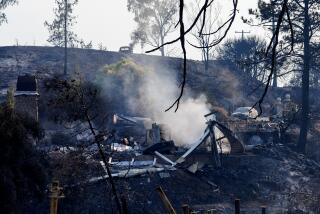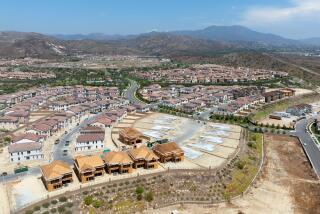Airport Foes Suggest Options of Their Own
Irvine Mayor Christina L. Shea is among those who see the future of the El Toro Marine Corps Air Station as harboring something more than just another airport, full of sound and fury and inciting a free fall of property values on nearby streets.
Shea sees a lavish new stadium housing a National Football League expansion team, playing host to the Cowboys and Packers on autumn Sundays, next to a state-of-the-art convention center fit for the Republican National Convention.
Laguna Hills Councilman Randal J. Bressette envisions a “high-tech center,” joined with a major university--perhaps, say, the Stanford of Orange County--coupled with a championship golf course tailored for the likes of Tiger Woods and Greg Norman.
Ardent opponents of a commercial airport at the base, Shea and Bressette have begun to articulate what amounts to a new strategy for those who don’t want an airport at El Toro and will do almost anything to stop it.
Both belong to a growing and increasingly vocal contingent who believe not only that the county’s environmental impact report for El Toro is radically flawed but also that the region is selling itself short in contending that an airport is the best moneymaker going.
In other words, Bressette said, “Follow the money. . . . And if you do, you’ll find that a lot of other uses are potentially much more lucrative--and much less harmful to the environment--than an airport would be.”
Supporting their argument is a study commissioned last fall by the El Toro Reuse Planning Authority that purported to show, in voluminous detail, how non-aviation uses, anchored by a theme park and racetrack, would generate far more revenue than an airport.
Exploring seven different scenarios, the study concluded that a combination of uses--such as a theme park, racetrack, hotels, apartments and light industry--would produce substantially more in net annual revenue than even a large commercial airport spanning 2,000 acres or more.
However, the one caveat would be that an airport would be more profitable in the short term. Even the county’s own assessment agreed that other uses might yield more by the mid-point of the 21st century.
Over a 30-year period, the theme-park scenario would generate about $11.3 million a year, as compared to the $7.8 million a year from a commercial airport, according to the study commissioned by the anti-airport group.
In December, the Orange County Board of Supervisors voted to scale back the airport proposal--which it endorsed--by limiting the number of passengers from the original goal of 38 million a year to 25 million a year or even as few as 10 million a year.
But Roger Noll, a professor of economics at Stanford University, doesn’t think a smaller airport will perform economically--or, for that matter, a theme park or sports facility, either.
He said the airport would serve as a powerful economic generator only as a much larger facility than John Wayne Airport that acts as a “hub” for passengers crisscrossing the country.
“That way,” Noll said, “you can easily imagine a humongous employment effect. You’d be talking thousands of jobs from the airport alone. In fact, it could become the economic engine that drives the whole area.”
It would be pointless, he said, to view a downsized El Toro airport as having an economic advantage or even being necessary. He ridiculed the notion that a theme park or stadium complex would rival an airport in bringing in revenue.
“The thing that leaps to mind,” Noll said with a laugh, “is how Orange County is so bereft of theme parks. And certainly, a sports facility is completely a loser from an economic development standpoint. That would have no more impact on the local economy than building a pyramid.”
Nevertheless, the anti-airport faction is forging ahead with a myriad of ideas designed to accommodate almost anything at El Toro except commercial aircraft.
Coupled with their desire to highlight other uses is a new tactic only now gaining momentum: The no-at-El Toro faction envisions an expanded John Wayne, free of what they call the artificial caps that currently restrict its scope and size.
Caps were placed on operating hours and traffic at John Wayne after a 1981 lawsuit filed by Newport Beach against the County Board of Supervisors. The caps cover the period from 1985 to 2005 and limit John Wayne to 8.4 million air passengers a year.
El Toro opponents contend that John Wayne could all but double its current capacity and serve close to 15 million air passengers a year. In short, the anti-El Toro faction sees an expanded John Wayne as one piece of weaponry in a new and far more aggressive battle plan.
“If the pro-airport people are so concerned about making sure that a regional airport stays in Orange County, then why don’t they do the right thing and take the caps off John Wayne?” said Lake Forest Councilman Richard T. Dixon, the new chairman of the El Toro Reuse Planning Authority and an ardent airport opponent. “I’m tired of their hypocritical attitudes.”
Newport Beach residents, of course, bitterly oppose an expanded John Wayne. And many in the pro-El Toro faction doubt the merits of the other side’s “spin,” which they call biased and short-sighted in assessing the long-term economic jolt of an airport in South County.
Clarence Turner, spokesman for the Airport Working Group and a former Newport Beach mayor, said the other side’s studies “are not sanctioned by anyone. In fact, all they did was hire a consultant and say, ‘Here’s our conclusions--now give us a study.’ ”
Turner said the anti-airport faction has failed to consider parking, traffic and environmental cleanup issues and is operating more from a feeling of hysteria than from reason and strength.
He called the idea of expanding John Wayne “a simplistic approach” and said it would raise even more environmental concerns than a new airport at El Toro.
“They’re losing,” he said of the other side. “And if we get a directive to amend our EIR, well, it merely gives us a blueprint of how to fix it--of how to make our plan perfect . . . which we will do.”
Turner laughed at the idea of a university cropping up at El Toro, noting that Orange County already is home to UC Irvine, Cal State Fullerton, Chapman University and others.
He also scoffed at the concepts of a theme park and stadium, noting that the National Football League is far more interested in putting an expansion team in Los Angeles than it ever would be in Orange County.
He was supported in that assessment by NFL spokesman Greg Aiello, who said recently that unless current plans fall through, the league is proceeding with putting its next L.A.-area team in a renovated Coliseum near USC.
However, Aiello said, “If that turns out not to be feasible, we would start considering other alternatives. . . . We would have to”--meaning, in that scenario, that Orange County and Irvine’s Mayor Shea would at least have a fighting chance, albeit a remote one.
Nevertheless, sources close to the anti-airport effort said Friday they have begun to pursue the stadium idea much more aggressively and may have a major announcement later this week.
Even county officials, in releasing their agenda for carrying out phase two of the airport planning process, promised in the statement released Friday to “vigorously” pursue non-aviation alternatives at El Toro--including, but not limited to, a stadium complex.
Still, for the opponents of an airport at El Toro, there is but one bottom line.
The virtues of stadiums, racetracks and theme parks notwithstanding, Dixon, the Lake Forest councilman, said the county needs to consider not what’s appropriate for the next generation “but the next generation’s grandchildren . . . and, I’m sorry, but an airport at El Toro just isn’t it.”
More to Read
Sign up for Essential California
The most important California stories and recommendations in your inbox every morning.
You may occasionally receive promotional content from the Los Angeles Times.










